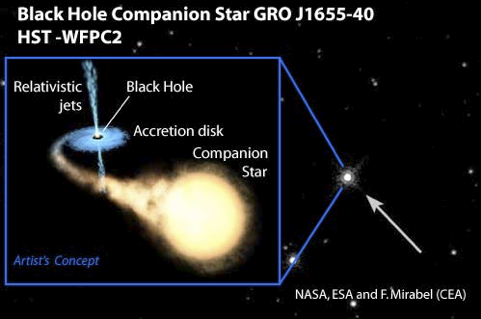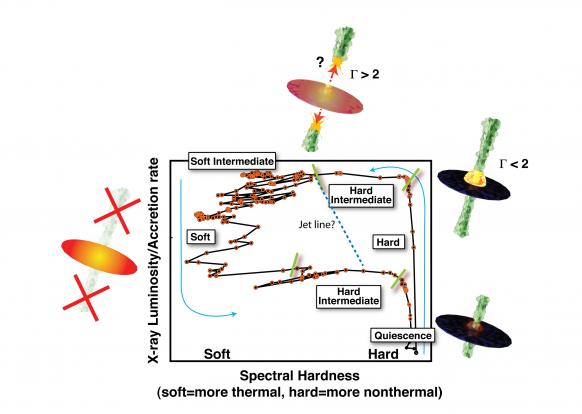X-ray Binaries (XRBs):
When a star is massive enough (much more than our sun), it eventually dies in an explosion called a supernova. Depending on the star’s original mass, it will leave behind a relic compact object — either a neutron star (NS) or a black hole (BH). In fact most stars form in binary systems (the two stars orbit each other), and if one dies first, forming a compact object, it can “feed” off its companion star via the accretion process. Because the system has net angular momentum, the captured material will settled into a disk, called an accretion disk. A similar process leads to the formation of proto-planetary disks, which is why the planets orbit our sun roughly in a disk as well.
As the material infalls, it interacts via viscous processes, and in the process both transfers angular momentum, allowing material to move within the disk, and heating the material (not unlike rubbing your hands together will heat them via friction). At the innermost regions close to the compact object, the disk becomes extremely hot and emits X-ray radiation, which is how these systems were originally discovered via rocket experiments in the 1960’s (link?). Specifically, we refer to these objects as neutron star X-ray binaries (NSBs) or black hole X-ray binaries (BHBs), although it turns out that they radiate across the entire electromagnetic spectrum (we just didn’t know this at the time). XRBs are found throughout our Galaxy, the Milky Way. Because they are just a later stage of stellar evolution, wherever stellar populations age, we find these and other relic compact objects.
The Physical Ingredients of an XRB: There are several different components to an XRB, and a cartoon is shown in the fIgure below. Because we cannot directly image (“see”) the separate components of the system, which mostly looks like a blob to our best telescopes, it makes it difficult to know which component contributes what to the energetic output of the source. We usually measure this output as a spectrum from the radio through X-ray and sometimes even γ-ray wavebands. Understanding the degree to which each component contributes to the overall emission properties of an XRB is one area of research activity in our group, and necessary to constrain the internal physics.
First there is the companion star that feeds the accretion disk. This star can have temperatures from a few up to tens of thousands of degrees Kelvin, and the star emits thermal radiation (similar to a lightbulb). The accretion disk also emits thermal radiation: the outer edges can sometimes be seen in the infrared (IR) bands, but the inner regions can be millions of Kelvin, corresponding to the “soft” (lower) X-ray bands. We infer the presence of a plasma of even hotter particles via the fact that we sometimes also see “hard” (higher energy) X-ray emission, but the geometry of this X-ray corona is not yet clear. It could be a layer above the inner accretion disk, or the entire inner accretion flow itself, or even the base of the jets. The jets are another big mystery. Somehow, some of the material accreting onto the compact object either escapes or powers the launching of relativistic flows of plasma, both contained by and containing strong magnetic fields. Jets emit non-thermal radiation at essentially all wavelengths, from low-energy radio waves to high-energy X-rays and potentially γ-rays. Finally, some of the radiation emitted from the inner regions can also reflect off the accretion disk. These components are intertwined and especially near the compact object can be altered by strong gravitational and electrodynamic effects. In fact, there is still much debate over the physical nature of these components, and over which components contribute most significantly to the observed radiation from XRBs. Sophisticated semi-analytical models and numerical simulations are some of the tools employed by our group to help us learn more about the physics of these complex regions.

XRB Evolution:
XRBs can be either persistent (accreting at a stable level over their lifetimes) or
transient sources. In the latter case, they spend most of their lives accreting at an almost negligible level, in what we call quiescence. At seemingly unpredictable periods, these transient XRBs undergo outburst cycles lasting months to years, probably fueled by instabilities in the accretion flow leading to a sudden influx of material into the accretion disk.
We are mostly interested in BHBs in our group, and the following description applies only to these sources. During an outburst, BHBs exhibit a series of configurations, as inferred from radio, IR and X-ray telescopes, that we classify into accretion states. While it is not entirely clear what drives these state transitions, we have a general idea of the relative contributions of different components to the total observed emission over the course of an outburst, illlustrated in the schematic below. This type of diagram shows a common phase space used to classify the system, with X-ray spectral hardness (corresponding to either thermal- or nonthermal dominance) on the bottom axis, and X-ray intensity (corresponding roughly to accretion rate) on the side axis.
Once an outburst begins, a BHB rises out of quiescence in the bottom right corner progress around the loop counterclockwise. As soon as they are detected, these objects in this state are associated with steady, compact jets, usually observed in the radio and IR bands. At near the maximum allowed brightness (interestingly dictated by the mass of the black hole), the emission becomes increasingly dominated by thermal emission from the accretion disk, and the BHB evolves to the left along the top horizontal track. The jets transition from steady flow (like a firehose) to either ballistic blobs, or are riddled with internal shocks (we are not yet sure what is going on exactly) around a region of phase space called the “jet line”. Then the system becomes fully dominated by the thermal accretion disk, and the jets are seemingly quenched. At some point the accretion rate begins to decrease, and the BHB dims while remaining in the thermal, disk-dominated state, until transitioning back to a non-thermal state with steady jets again. This journey back to the lower-right hand corner always occurs at a lower luminosity, involving some sort of hysteresis effect, again the driver of which is not yet understood. The schematic below illustrates this process with real data from Galactic BHB GX339-4 (based on work by Corbel et al., Belloni et al.), showing the expected system configuration through the cycle. This picture was originally proposed by Fender, Belloni & Gallo (2004) and most outbursts show something like this behavior, though sometimes we see “failed transitions” where some objects fail to make it all the way around the cycle. A typical outburst lasts months to a year, though there can be wide variations.

AGN:
Active Galactic Nuclei (AGN) are among the most luminous objects in the universe, some emitting as much radiation as a trillion suns. Because AGN are so luminous, we can see them to extremely large (“cosmological”) distances, where we actually need to make corrections to factor in the expansion of the universe as their light travels to us. The most distant AGN are almost 13 billion light years from the Earth, allowing us to probe the Universe when it was only a few hundred million years old! AGN encompass a variety of different classes, but all are essentially driven by the same process we observe on the BHBs, except that the central object is a much larger black hole at the center of a galaxy. Accretion onto a black hole of this size is essentially the only mechanism that can release this much energy so quickly. The central black hole must be millions to billions times more massive than the black holes driving BHBs. Like BHBs, some AGN also launch relativistic jets. Just as AGN are more luminous than BHBs, AGN jets often extend to much larger distances too, with the largest AGN jets being millions of light years across. For comparison, all the stars in our Galaxy, the Milky Way, occupy a space that is (only) ~100,000 light years across. AGN, and especially their jets, emit radiation across the entire electromagnetic spectrum and are among the brightest radio, X-ray, and Gamma-ray sources in the entire sky. Like for XRBs, multiwavelength studies are essential to understand AGN physics.
AGN and the Bigger Picture:
AGN are intimately connected to the hierarchal galaxy building process. Probably every large galaxy hosts a supermassive black hole (SMBH) at its center (even the Milky Way). These SMBHs were likely formed through a series of galaxy mergers, with smaller black holes eventually coalescing into larger and larger ones. Although most galaxies’ SMBHs are now dormant, every large galaxy likely went through at least one AGN phase. The AGN phase probably corresponds to a very dynamic period of the galaxy’s life, when the galaxy (and its central SMBH) were forming most vigorously and fuel for the accretion disk was plentiful. So, in addition to allowing us to study the physical processes of black hole accretion, AGN also provide us a glimpse of galaxy formation. Furthermore, the energy released by AGN (in the form of light, mechanical energy from the jet, or alternately a disk “wind”) gets deposited back into its host galaxy, forming a feedback loop between the host galaxy and the central AGN. So, although a SMBH is localized to just the very center of a galaxy, the entire inner galaxy is very aware of an AGN’s presence. Understanding black hole accretion and jet/wind physics is thus a very important step toward understanding how galaxies form and why they look the way they do today, including our own Milky Way.
Mass Scaling:
Einstein’s theory of general relativity predicts that the effect of black holes on spacetime scales in a predictable way with black hole mass. Black holes are found with masses ranging from 10 to 10 billion times the mass of our sun, and different ends of the mass scale offer different (and often complementary) insight. For example, BHB outbursts (and the launching and quenching of powerful jets) can be monitored on “human” timescales, since they last only months to years. This allows for very detailed observations to constrain or exclude different models of black hole accretion and jet formation. However, only two to three dozen BHBs have been discovered in our Milky Way so far, despite our expectation that there are myriads, because we can generally only find them when they go into outburst. With such a small population, it is statistically challenging to draw conclusions about their behaviors as a class. The vastly larger number of known SMBHs, with over a million AGN so far catalogued from surveys like the Sloane Digital Sky Survey (SDSS–link), provides the requisite backdrop to perform statistical studies to isolate universal behavior from anomalies. However, because of their larger black holes, it would take an AGN millions to hundreds of millions of years to undergo similar episodes as black hole XRBs during outbursts. By simultaneously considering accreting black holes across the entire black hole mass scale, we can take a more holistic approach toward understanding black hole accretion.
